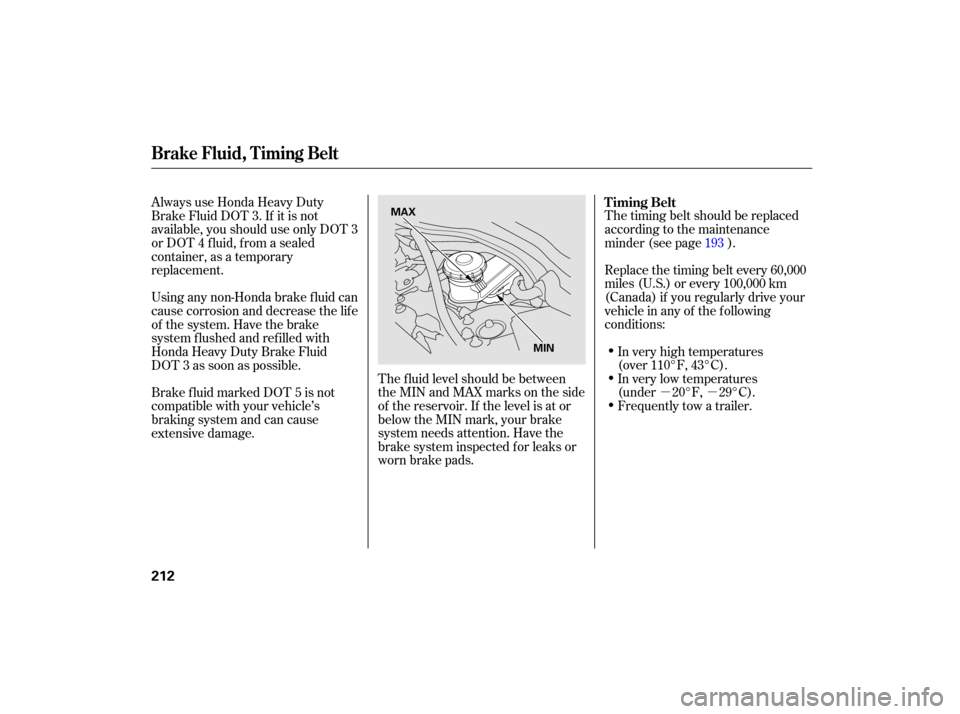Page 215 of 287

�µ�µ
The timing belt should be replaced
according to the maintenance
minder (see page ).
Replace the timing belt every 60,000
miles (U.S.) or every 100,000 km
(Canada) if you regularly drive your
vehicleinanyof thefollowing
conditions:
In very high temperatures
(over 110°F, 43°C).
In very low temperatures
(under 20°F, 29°C).
Frequently tow a trailer.
The f luid level should be between
theMINandMAXmarksontheside
of the reservoir. If the level is at or
below the MIN mark, your brake
system needs attention. Have the
brake system inspected f or leaks or
worn brake pads.
Always use Honda Heavy Duty
Brake Fluid DOT 3. If it is not
available, you should use only DOT 3
or DOT 4 f luid, f rom a sealed
container, as a temporary
replacement.
Using any non-Honda brake f luid can
cause corrosion and decrease the lif e
of the system. Have the brake
system f lushed and ref illed with
Honda Heavy Duty Brake Fluid
DOT 3 as soon as possible.
Brake f luid marked DOT 5 is not
compatible with your vehicle’s
braking system and can cause
extensive damage.
193
Timing Belt
Brake Fluid, Timing Belt
212
MAX
MIN
06/08/08 14:50:34 31SDR620_217
Page 231 of 287

When installing cables, f ollow the
manuf acturer’s instructions, and
mount them as tight as you can.
Make sure they are not contacting
the brake lines or suspension. Drive
slowly with them installed. If you
hear them coming into contact with
the body or chassis, stop and
investigate. Remove them as soon as
you begin driving on cleared roads.
Because your vehicle has limited tire
clearance, Honda strongly
recommends using the chains listed
below, made by Security Chain
Company (SCC). Mount tire chains on your tires when
required by driving conditions or
local laws. Install them only on the
f ront tires.
Cable-types: SCC Radial Chain
CH2311T or SCC SC Cable SC1030T ire Chains
Tires
228
Using the wrong chains, or not
properly installing chains, can
damage the brake lines and
cause a crash in which you can
be seriously injured or killed.
Follow all instructions in this
owner’s manual regarding the
selection and use of tire chains.
Traction devices that are the wrong
size or improperly installed can
damage your vehicle’s brake lines,
suspension, body, and wheels. Stop
driving if they are hitting any part of
the vehicle.
06/08/08 14:53:07 31SDR620_233
Page 234 of 287

Support the f ront wiper blade
arms with a f olded towel or rag so
they do not touch the windshield.
To minimize sticking, apply a
silicone spray lubricant to all door
and trunk seals. Also, apply a
vehiclebodywaxtothepainted
surfaces that mate with the door
and trunk seals.
Cover the vehicle with a
‘‘breathable’’ cover, one made
f rom a porous material such as
cotton. Non-porous materials, such
as plastic sheeting, trap moisture,
which can damage the paint.
Leave the parking brake off. Put
the transmission in Park.
Block the rear wheels.
If the vehicle is to be stored f or a
longer period, it should be
supported on jackstands so the
tires are of f the ground.
Leave one window open slightly (if
the vehicle is being stored
indoors).
Reconnect the 12 volt battery and
drive your vehicle every month f or
about 30 minutes. This will keep
the IMA battery charged and in
good condition.
Disconnect the 12 volt battery.
Vehicle Storage
Maint enance
231
If this vehicle is unused f or over one
month, the service lif e of the 144V
Nickel-Metal Hydride battery will be
reduced and the battery may be
permanently damaged.
06/08/08 14:53:34 31SDR620_236
Page 236 of 287

This section covers the more
common problems that motorists
experience with their vehicles. It
gives you inf ormation about how to
safely evaluate the problem and what
to do to correct it. If the problem has
stranded you on the side of the road,
you may be able to get going again.
If not, you will also f ind instructions
on getting your vehicle towed.
......................Compact Spare Tire . 234
....................Changing a Flat Tire . 235
.............If the Engine Won’t Start . 239
Nothing Happens or the
Starter Motor Operates
............................Very Slowly . 239
The Starter Operates
................................Normally . 240
................................Jump Starting . 241
..............If the Engine Overheats . 243
.........Low Oil Pressure Indicator . 245
..........Charging System Indicator . 245
.......Malf unction Indicator Lamp . 246
.......................Readiness Codes . 246
...............Brake System Indicator . 247
..................Closing the Moonroof . 248
..............................................Fuses . 249
..............................Fuse Locations . 253
......................Emergency Towing . 255
Taking Care of the Unexpected
T aking Care of t he Unexpect ed
233
06/08/08 14:53:40 31SDR620_238
Page 238 of 287

Unscrew the wing bolt and take
the spare tire out of its well. Take the tool tray out of the trunk,
and take the tools out of the tool
tray.
Park the vehicle on f irm, level, and
non-slippery ground. Put the
transmission in Park. Apply the
parking brake.
If you are towing a trailer, unhitch
the trailer.
Turn on the hazard warning lights,
and turn the ignition switch to the
LOCK (0) position. Have all
passengers get out of the vehicle
while you change the tire.
The tools are in the trunk. Open
the trunk and raise the trunk f loor
by lif ting up on the back edge.
If you have a f lat tire while driving,
stop in a saf e place to change it.
Drive slowly along the shoulder until
you get to an exit or an area to stop
that is far away from the traffic lanes.
5. 4.
3. 2. 1.
CONT INUED
Changing a Flat Tire
T aking Care of t he Unexpect ed
235
TOOL TRAY
The vehicle can easily roll off
the jack, seriously injuring
anyone underneath.
Follow the directions for
changing a tire exactly, and
never get under the vehicle
when it is supported only by the
jack.
06/08/08 14:54:01 31SDR620_240
Page 240 of 287
CONT INUED
Tighten the wheel nuts securely in
the same crisscross pattern. Have
the wheel nut torque checked at
the nearest automotive service
f acility.
Tighten the wheel nuts to:
Put on the spare tire. Put the
wheel nuts back on f inger-tight,
then tighten them in a crisscross
pattern with the wheel nut wrench
until the wheel is f irmly against
the hub. Do not try to tighten the
wheel nuts f ully.
Lower the vehicle to the ground,
and remove the jack.
Bef ore mounting the spare tire,
wipeanydirtoff themounting
surface of the wheel and hub with
a clean cloth. Wipe the hub
carefully;itmaybehotfrom
driving. 13.
11.
12.
10.
Changing a Flat Tire
T aking Care of t he Unexpect ed
237
BRAKE HUB
80 lbf·ft (108 N·m , 11 kgf·m)
06/08/08 14:54:18 31SDR620_242
Page 244 of 287

�´�´
Although this seems like a simple
procedure, you should take several
precautions. Open the hood, and check the
physical condition of the battery.
In very cold weather, check the
condition of the electrolyte. If it
seems slushy or f rozen, do not try
jump starting until it thaws.
You cannot start your vehicle by
pushing or pulling it. The numbers in the illustration show
the order to connect the jumper
cable.
Put the transmission in neutral or
Park, and set the parking brake. Turn of f all the electrical acces-
sories: heater, A/C, climate
control, stereo system, lights, etc. Connect one jumper cable to the
positive ( ) terminal on your
battery. Connect the other end to
the positive ( ) terminal on the
booster battery.
1.
2.
3.
CONT INUED
Jump Starting
To Jump Start Your Vehicle:
T aking Care of t he Unexpect ed
241
BOOSTER
BATTERY
A battery can explode if you do
not follow the correct procedure,
seriously injuring anyone
nearby.
Keep all sparks, open flames,
and smoking materials away
from the battery.If a battery sits in extreme cold, the
electrolyte inside can f reeze.
Attempting to jump start with a f rozen
battery can cause it to rupture.
06/08/08 14:54:59 31SDR620_246
Page 246 of 287

If you see steam and/or spray
coming f rom under the hood, turn
of f the engine. Wait until you see
no more signs of steam or spray,
then open the hood.If you do not see steam or spray,
leave the engine running, and
watch the temperature gauge. If
the high heat is due to overloading,
the engine should start to cool
down almost immediately. If it
does, wait until the temperature
gauge comes down to the midpoint,
then continue driving.
If the temperature gauge stays at
the red mark, turn of f the engine.
Look f or any obvious coolant leaks,
such as a split radiator hose.
Everything is still extremely hot,
so use caution. If you f ind a leak, it
must be repaired bef ore you
continue driving (see
on page ).
The pointer of the vehicle’s
temperature gauge should stay in
the midrange. If it climbs to the red
mark, you should determine the
reason (hot day, driving up a steep
hill, etc.).
If your vehicle overheats, you should
take immediate action. The only
indicationmaybethetemperature
gauge climbing to or above the red
mark. Or you may see steam or
spray coming f rom under the hood.
Saf ely pull to the side of the road.
Put the transmission in neutral or
Park, and set the parking brake.
Turn of f all the accessories, and
turn on the hazard warning lights.
1.
2. 3.
4.
5.
255
CONT INUED
Emergency
Towing
If theEngineOverheats
T aking Care of t he Unexpect ed
243
Steam and spray from an
overheated engine can
seriously scald you.
Do not open the hood if steam
is coming out.
Driving with the temperature gauge
pointer at the red mark can cause
serious damage to the engine.
06/08/08 14:55:19 31SDR620_248